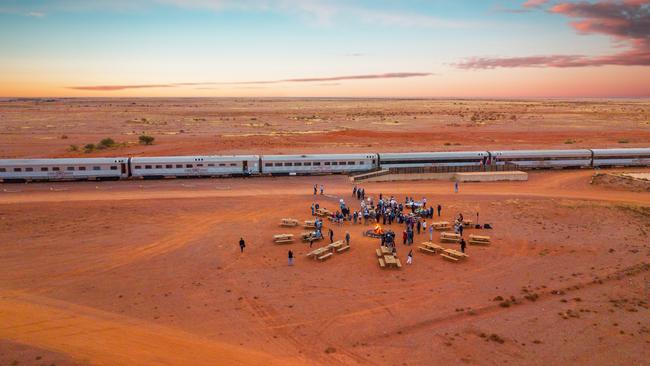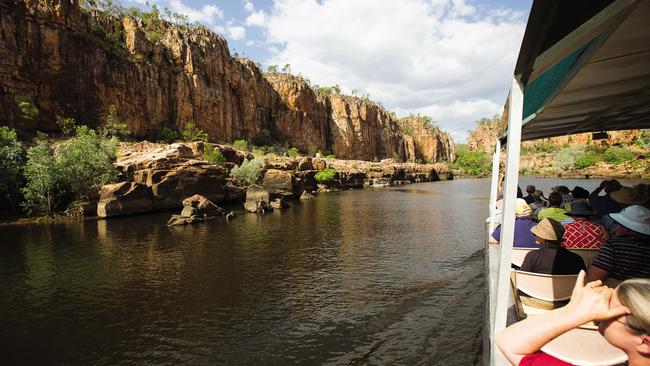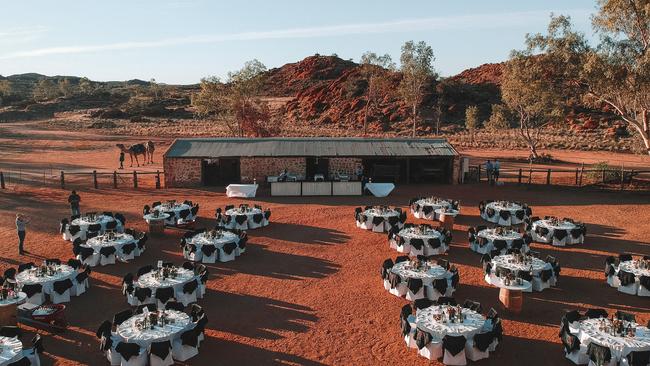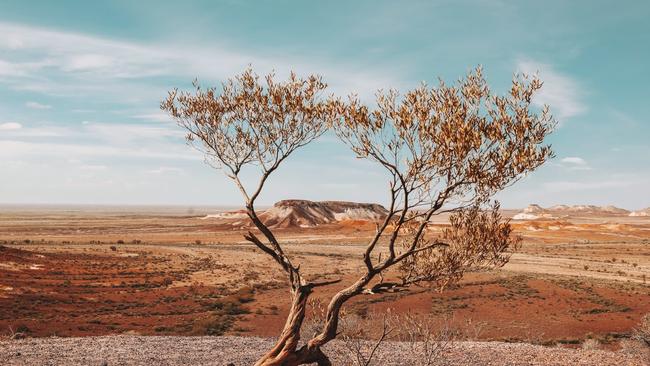The Ghan train journey
This train journey is not about simply getting from A to B. What really matters is what lies in-between.

You don’t sign up for the 2979km Ghan train journey to get from Darwin to Adelaide (or vice versa). This an experience in the slow lane, a chance to unpeel transcontinental contradictions: hostile then welcoming; bucolic then barren. Often we fly over the top of the country, our heads in books and shades pulled, rather than observing what’s in the middle. But there’s something to be said for the unfiltered in-between, observed at ground level.
My four-day journey begins in steamy Darwin, where The Ghan’s kilometre-long silver carriages and red locomotives gleam in the Top End sun. The music in the air is courtesy of a local crooner, regaling passengers with renditions of Australian country hits from the 1980s. I’m pretty sure he’s playing John Williamson’s True Blue as we board.

My Gold Service twin cabin is in carriage C. It’s compact but equipped with everything needed for a comfy stay. Every bit of space has been maximised. A bench seat is my perch to watch the movie-reel of countryside unfolding outside by day. By night, it flattens into a single bed; an upper bunk descends for a travelling companion. A private ensuite is equipped with a shower and toilet.
As we ease out of the station through Darwin’s thick mangroves and fruit plantations, the conductor enters my cabin via the PA system. His melodic voice fills the air with insights into the places we’ll be passing, as well as interesting facts from the train’s history. In its current incarnation, The Ghan has been plying this north-south route since the Alice Springs to Darwin rail link was completed in 2004. But the story of the train – or at least its potential – goes back to the mid-1800s.
Settlers venturing deep into Australia’s vast unknown interior in the 19th century had a light-bulb moment. What’s the best way to traverse this hostile terrain? Camels were deemed the ideal solution. The Arabian variant was imported to carry mail and essential goods cross-country, and today Australia is home to the world’s largest population of wild dromedaries. There was one hitch, however. The settlers had no clue how to train the animals. That’s how cameleers from across the Middle East and modern-day Afghanistan found themselves in this arid land.

In 1878, the first train tracks were laid between Port Augusta in South Australia and Alice Springs in the Northern Territory, roughly tracing the route the cameleers used. It was completed in 1929. The first locomotive to mount the rails was affectionately called The Ghan, in tribute to those Afghani pioneers, and it carried more cargo than people.
I suspect the original train’s passengers lacked most of the comforts we now enjoy – a flute of sparkling wine and pastries in the lounge carriage feels like a fitting entree to today’s arrival in the town of Katherine. Each day brings a choice of off-train excursions. Some are shuttled to airstrips for helicopter tours over Nitmiluk (Katherine) Gorge, while I opt to cruise through it with new friends, having bonded over breakfast fizz.
Exploring this cavernous pocket of the territory, 1650 million years in the making, is a humbling experience. Earth hosted no bone-bearing creatures back then, which explains the region’s lack of fossils. You can imagine the powerful Jawoyn creator, Bula, yawning as he made this landscape, now part of Nitmiluk National Park. These days the creatures are abundant; a sprinkling of crocs, the bubbles of barramundi and endangered pig-nose turtles, a flutter of glossy black cockatoos. It stops you in your tracks.

Nitmiluk’s necklace of 13 gorges is separated by bands of sandstone. We explore the first two, where the rocky ridges provide a glimpse of the landscape 20,000 years ago. The sheer cliffs dwarf silver-leaf paperbarks (used by the Jawoyn to smoke fish) and river pandanus that line the banks. A pair of white-bellied sea eagles catch a current, circling effortlessly above our boat and its surrounding flotilla of kayaks. Young holidaymakers tumble into the water and clamber up rocks only to somersault in again with splashes and shrieks; their parents, meanwhile, set kayaks to drift towards sandy beaches, avoiding those favoured by freshwater crocs for their nests.
Back on The Ghan, I settle into the steady rhythm of the train as it travels through timeless landscapes. It’s an arresting backdrop for dinner in Queen Adelaide restaurant, where the menu du jour might feature kangaroo loin with a salad of pickled cucumbers and rosella-flower chutney, or a twice-baked Adelaide Hills cheese souffle.
Ensconced in my cabin ready for bed, the only sounds are the groaning carriages easing south and the occasional ding-ding of level crossings. Sleep comes easily, thanks to the hypnotic combination of effortless motion and dinner’s excellent accompanying chardonnay (the experience is all-inclusive, after all). I open the blinds. Nothing beats dozing to a bedazzlement of outback stars.

Or waking up to the sight of the MacDonnell Ranges for that matter. The mountains cover a staggering four million hectares of red earth blanched by dusty greens, all framed by the endless blue sky. After breakfast, the train eases into Alice Springs, a city of 33,000 partly owing its beginnings to the railway line; in the first 10 months of the service, 15,000 head of cattle worth $436,000 were sent south.
Passengers embark on a range of tours, variously visiting the Royal Flying Doctor Service museum, Anzac Hill and its World War I memorial, a wildlife preserve and Simpsons Gap, the mythological home of the Arrernte traditional landowners’ giant goanna ancestors. As dusk falls, groups reunite at Alice’s Telegraph Station, just out of town. Old river red gums stand guard over a cluster of buildings that saw Stuart – as Alice was once called – become an integral part of the telegraph line linking London with Darwin and Adelaide. It opened in 1872, slashing communication times from two months to three hours.
But we’re not here for a history lesson. We’re here to feast. Bonfires, barbecues and basted barramundi perfume the air. South Australian wine bottles never seem to go empty, and soon I’ve summoned the courage to hit the dusty dance floor spread before the band. I imagine this is what the mature traveller’s Burning Man looks like.

In the morning I’m pleased to recall that my tipsy self had sufficient presence of mind to wash off the evening’s revelry – a puddle of ochre decorates my shower floor. After a fortifying breakfast, middle-of-nowhere Manguri “station” appears on the horizon, the day’s heat creating a surreal ripple through the air as the train brakes.
This is the gateway to Coober Pedy, a place where any familiar sense of perspective quickly dissolves. The moonscape of fossilised shells, sandstone and cracked grey clay is pancake flat, save for hundreds of pits and termite-like mounds that pock the Earth’s surface – evidence of opal prospectors. Rusted-out cars abound, creating the illusion of a post-apocalyptic wasteland. Tufts of buffalo grass are the only foliage; taipans and small marsupials the only creatures. The circle of life doesn’t get any tighter. Not surprisingly, no enhancements were needed when Coober Pedy was chosen as the backdrop for the 1985 blockbuster Mad Max Beyond Thunderdome. NASA reportedly put its hand up to use the desertscape for training astronauts bound for the moon and Mars.

There’s a disturbed sound of silence here. Every word evaporates as fast as rain hitting the gypsum-flecked sand. Coober Pedy is officially one of the hottest places on the planet, where daytime summer temperatures rarely drop below 35C; an egg-frying 47.8C is the record. Water doesn’t last long above ground. Nor do humans, which is why most of the town’s 1800 residents live in caves. When locals do emerge from their cool subterranean dugouts, entertainment consists of a drive-in movie theatre (car owners are warned to leave their explosives at home) and a golf course, minus the grass (golfers carry their own piece of turf and use glow-in-the-dark balls). Signs around town warn visitors of the landscape’s many unmarked holes, reminders of past digs.
On our way back to The Ghan we pause at the century-old Dog Fence, stretching 5400km across three Australian states, built with the goal of keeping sheep and dingoes separated. It seems effective, until we see a camel barge through without a second thought. We toast the day atop a mesa in the Kanku-Breakaways Conservation Park, the eroded hills nearby striated in vivid orange, red and white. Surely this should be the Australian flag.
When I glimpse the Flinders Ranges on our final morning, the journey is nearing its end. The desert reds fade to dusty greens and the parched yellows of the state’s wheatbelt. And then we’re in suburban Adelaide, its pretty churches never far from the tracks. I disembark a little dustier, a lot more relaxed, and far less likely to lower my window shade the next time I fly over Australia’s extraordinary Red Centre.
In the know
The four-day Ghan Expedition itinerary runs from April 1 to October 30 next year. The three-day journey from Adelaide to Darwin operates from February 1 to November 30, but only runs in the opposite direction in March and November 2023. Various classes of accommodation are available, including several tiers of Gold as well as Platinum. Rates cover all meals, standard alcoholic and non-alcoholic beverages, off-train excursions and outback experiences. Private transfers to and from stations are included in Platinum rates. From $3595 a person in a Gold Service twin cabin; $4245 next year.
Natasha Dragun was a guest of Journey Beyond Rail.

To join the conversation, please log in. Don't have an account? Register
Join the conversation, you are commenting as Logout